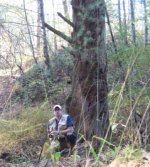You got two different situations between the northwoods and the SE.
In the SE, the land was settled slowly by farmers. I think every bit of it got cleared, there were no real "regions" which were "missed". Many farmers left a tree here and there, so "virgin" individual trees are relatively common, while "virgin" forests are pretty much non-existant.
In the rest of the state, including our "northwoods", the area was largely unsettled when the logging boom hit. They just started clearcutting, a huge advancing front, and they took pretty much every tree of reasonable size. They didn't miss a tree here and there in the areas logged. So you don't see these huge, old, but lonely trees around. But there were areas that were presettled and logged prior to the "boom", and there were other areas they actually missed or skipped.
So, you have huge expanses of second growth forest, all of it logged at a similar time. You have small pockets which were already logged and regrowing at that time, they are also second growth, but we commonly call them "old growth". And we have small pockets of "virgin" forest.
I'm sure there's literally dozens of virgin areas of PA. Cook Forest's 4 different stands being the most impressive. I'll add 3 more:
1. Heart's Content, Warren County. The virgin timber is around 20 acres. The family which owned the logging company active in the area had a hunting camp here and preserved it. White Pine, Hemlock, and Beech. The white pine is all exactly the same age, around 350 years old. It is assumed that it started during a fire or tornado. The beech and hemlock range from saplings to over 400 years old, so obviously some survived whatever the disturbance was. The site previously had the largest tree in PA, a white pine over 190 ft. But this tree died a decade or so back, and the top has fallen off, thus giving the title to the Longfellow Pine in Cook Forest.
2. Tionesta Natural area has some areas of virgin forest.
3. A smaller along Kitchen Creek in Rickett's Glen. Virgin white pine stand. Trees aren't anywhere near as tall as the ones in the western side, though, I think there's one around 140 ft.






